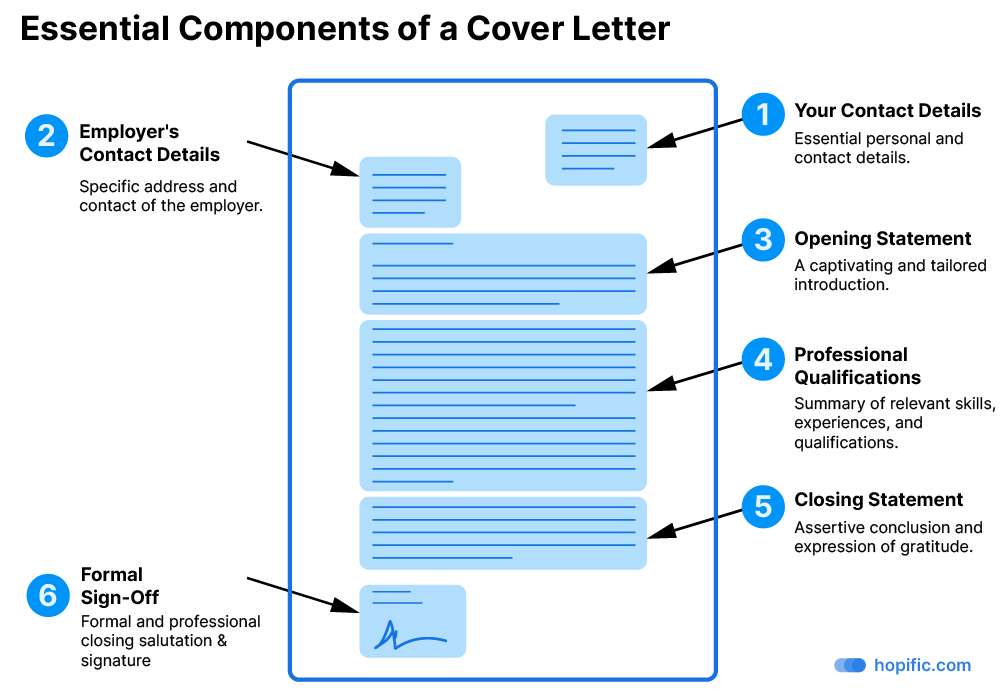Picture this – you’ve discovered the perfect architecture internship. It’s at a prestigious firm you admire, working on the kind of projects you’ve dreamed of. You put together a portfolio with your most striking projects and now, the only thing standing between you and that door-opening opportunity is one thing: your cover letter. In this guide we are going to learn how to write a cover letter for an architecture internship to maximize your chances.
Don’t make the mistake of thinking that the cover letter is just a formality. It’s your chance to make a memorable first impression that can make you stand out from other applicants. While the portfolio showcases your design and technical skills, the cover letter allows you to make your case why you are the best candidate for the internship.
But how do you write a cover letter that commands attention, that effectively communicates your suitability for the architecture internship? Having seen my fair share of internship applications as an experienced architect, I’m here to guide you through this process with practical tips, so you can maximize your chances of landing that internship.
We’ll go through the process of drafting your architecture internship cover letter step by step. From researching the company to fine-tuning the final details, focusing on what matters.
So, are you ready to give your architecture career a boost? Let’s dive in!
Step 1: Research the Company
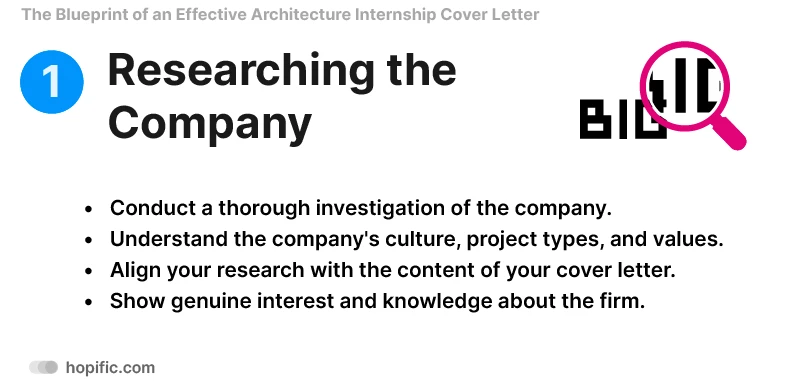
A month ago, our hiring manager got an email application for an internship. The email went something like this:
To whom it may concern,
With this email I would like to apply to the position of architectural intern in your firm. Please find my portfolio attached.
I’m looking forward to hearing from you,
Applicant Name
But that’s not even the good part. The applicant sent this email not only to our design firm but to another 7 architecture firms, and we know because they were all copied in the email! Funny enough some of the other recipients were some of our biggest competitors.
Now why do I mention this?
Put yourself into the person’s shoes who is tasked to screen application emails.
First, you notice that the person has applied not just to your firm but many others (every architecture firms wants to feel special after all!).
Second, the applicant did not make any effort to show that he knows your firm, your values, and what you are looking for in an intern.
Before you place your hands on the keyboard and start writing your cover letter make sure that you do an in-depth research about the company. Knowing your prospective employer inside and out can help you tailor your cover letter to their specific needs and culture.
I know that it may sound like a lot of work, you are probably applying to more than one firm after all, but trust me, it’s so, so important. Especially if you are not so confident about your portfolio, a strong cover letter can still get you that internship.
Start by diving deep into the company’s website. Familiarize yourself with their mission, values, and culture. Pay close attention to the types of projects they do. Are they focused on sustainable architecture? What are they most proud of? This research provides you with insights that will help you align your cover letter to the company’s values and project portfolio.
Also check out the company’s social media platforms. On social, the company might reveal a bit more of their company culture and what’s going on behind the scenes.
Once you identified their priorities and values, weave this knowledge into your cover letter authentically, demonstrating genuine interest and enthusiasm for the work they do.
Your goal is to paint a picture of how you can contribute and add value to their specific operations.
So, researching the company isn’t just a step to check off your list, it’s a strategic move in showcasing why you are a perfect fit for the internship position.
Specifically look for the following:
- Have they recently won a project? Mention any skills you have that could support the firm in that project.
- Is the firm particularly proud of a certain way of working or do they specialize in a particular kind of architecture? Highlight your authentic interest in those topics and that you want to learn from them.
- Equally, check for things that are missing. Do you have any skills that they don’t seem to have in-house that could be valuable to them? Subconsciously they will think that they’ll get an architect’s skills the ‘price’ of an intern!
- Do they seem to be very busy? If you are able to, let them know that you can start immediately.
Let your research guide you as you write your cover letter for your architecture internship and create a compelling narrative that mirrors the company’s objectives and demonstrates your potential as a prospective intern in their organization. Trust me, this little extra effort won’t go unnoticed.
Step 2: Start Strong: The Opening Paragraph
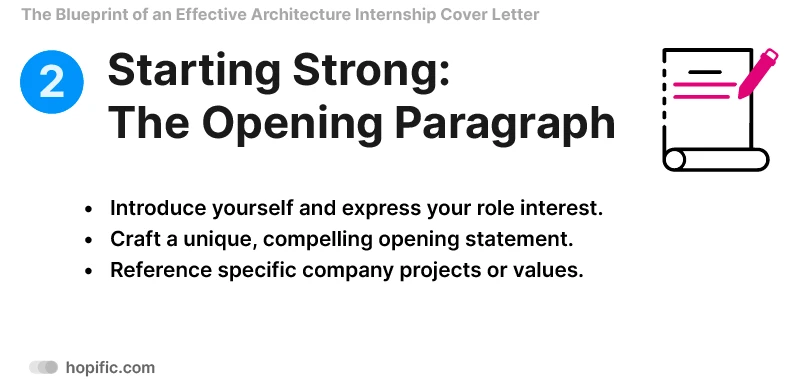
Now that you’ve armed yourself with knowledge about the company, it’s time to start crafting your cover letter. And, just like any compelling narrative, your cover letter needs a strong start. The opening paragraph is your first opportunity to grab the reader’s attention and first impressions count!
Introduce yourself and articulate your interest in the internship position clearly and concisely. Stay clear from generic introductions, try to construct a unique opening sentence that sets the tone.
Avoid the basic “I am applying for the architecture internship position.”
Instead, consider something more personalized. Here are a few examples to get you started:
When I first walked into [a building designed by the company], I was astounded by its [characteristic you genuinely like about it]. Now, as an aspiring architect, the opportunity to apply for the Architectural Internship at [Company Name] – is a dream come true.
As a passionate architecture student, I am eager to contribute to [Company Name]’s innovative and sustainable projects as an intern.
With my background in [Your Major or Related Experience], I am excited to bring a fresh perspective to [Company Name].
Having been inspired by [Company Name]’s remarkable designs and company culture, I am thrilled to apply for the Architectural Internship to contribute to and learn from such an innovative team.
As a lifelong admirer of [Company Name]’s commitment to urban sustainability, I can think of no place more fitting to embark on my journey as an architectural intern than with your team, who continually redefine the boundaries of green design.
In a few lines, not only have you expressed your interest in the role, but you have also demonstrated that you are familiar with their work. It’s a subtle way of saying that you didn’t randomly choose their firm, but are genuinely interested in being a part of their team.
Feel free to get creative, but remember to keep your tone professional yet enthusiastic. Let your excitement for the opportunity shine through your words. And, of course, keep it succinct. Rambling introductions can dilute the impact of your message.
Once you’ve caught their attention, briefly mention the skills and experiences that make you a strong candidate for the internship. Don’t go into too much detail here – you’ll have the opportunity to elaborate in the following section. The idea is to give the reader a snapshot of what’s to come.
An impressive start to your cover letter can set the pace for the rest of your letter. So, invest time in perfecting this initial paragraph.
Step 3: Express Your Skills and Qualifications
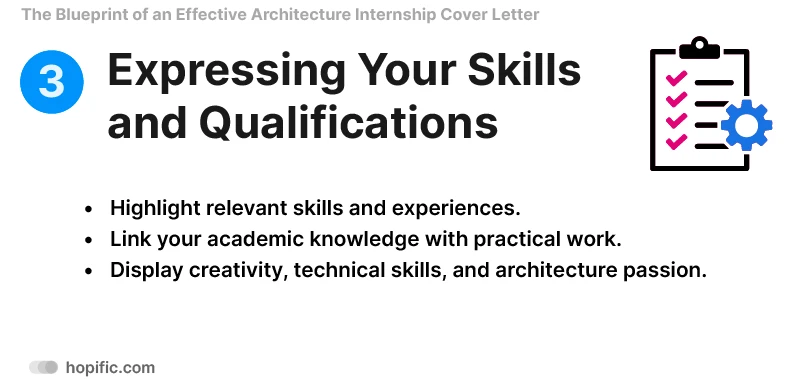
With a captivating opening paragraph under your belt, it’s now time to dig a bit deeper, giving your potential employer a glimpse into what you bring to the drafting table. Here, we’ll focus on expressing your skills and qualifications in a way that aligns with the internship you’re applying for.
I’ll be honest: when I applied for internships more then a decade ago, I thought I would join the firm to show off my (as I thought) great design skills, and that I’d contribute to designing their projects. When you write your cover letter for your architectural internship, consider that the reality of an architectural internship is that you’ll be primarily helping out in the production of projects. And at an early stage of your architecture career, that means knowing how to use architectural software.
If you are experienced in using architecture software like Revit, Rhino and Grasshopper, you are an expert user of the Adobe Suite, you are able to use any other specialized software, now is the time to mention it! Maybe you’re a fast 3D modeler or have a knack for sustainable design principles. Be specific and deliberate in detailing these hard skills.
Since architecture offices might not be the fastest in adopting new software, there is a good chance that your skills will be a valuable asset to them! Improving your architectural skills this way will significantly boost your chances. Especially when its in the realm of computational design, you might bring a skill to the table that will save them lots of time – increasing your chances of even turning your internship into a full-time offer later down the line!
If your internship is still a few weeks away, you still have time to upgrade your software skills. Mastering computational design can drastically enhance your application, setting you apart from other candidates. Check out our fast-track course on computational design with Grasshopper for Rhino here.
A word of advice though: If it’s not explicitly mentioned, make sure that you find out what kind of software your target company is using. If you are an expert Revit user and the company uses ArchiCad (another BIM software) – it will be of little use to them. And if you are in that situation, don’t still try to work with your own software, make an effort to learn the software the company uses!
To find out the company’s software stack, look at current employee’s LinkedIn profiles to check out their software expertise. Or perhaps the company mentions the software they use on their website or on social media posts (which is why the research part is so important!).
But architecture isn’t solely about the technical aspects. It’s also an art, a creative endeavor. So if you have outstanding design skills, proven in your portfolio, you will be considered to help out in design competitions or other early stage designs. So, weave in your creative competencies alongside your technical skills. To maximize your chance of being considered for your design skills, add any relevant information:
Have you won a design competition?
Have you worked on a project that showcases your innovative thinking or problem-solving abilities?
Do you have any previous internship experiences at reputable firms?
These experiences, though they may seem small, can have a substantial impact on your perceived value as a candidate.
Next, shed light on your academic achievements, linking them to the practical realm of architecture whenever possible. A strong academic record is always a plus. It proves your critical thinking abilities and your competence and diligence.
While discussing your qualifications, be careful not to merely list them. Instead, tell a story. How did you come to learn these skills? How have you utilized them in the past? Employers appreciate candidates who can demonstrate not just the possession of skills, but their application as well.
Finally, don’t forget to showcase your passion for architecture! An internship will be an intensive time and you’ll learn and work a lot. Your enthusiasm goes a long way to show that you are going to give it your all!
Step 4: Concluding Your Cover Letter
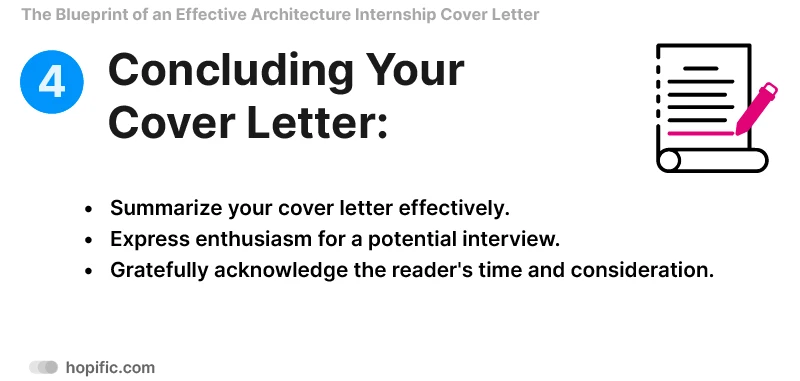
Having successfully highlighted your skills and qualifications, it’s time to bring your cover letter to a close. This section is perhaps the least important – but you can make sure to get it right with the following tips. The goal is to wrap up your narrative neatly and effectively.
Your conclusion should start by succinctly summarizing why you’re a good fit for the internship. Briefly(!) reiterate your key strengths and how these align with the firm’s needs.
Next, express your enthusiasm for the potential opportunity to interview. You could write something like:
“I look forward to the chance to delve deeper into how my background and skills can add value to your firm, even in a temporary internship role, during a potential interview.”
“I am excited about the chance to elaborate during an interview on how my abilities and experiences can support your team’s projects for the duration of this internship.”
This statement conveys your interest in moving forward in the process without presuming anything.
Finally, remember to thank the reader for their time and consideration. This expression of gratitude not only showcases your manners but also displays a level of professionalism that can set you apart from other candidates.
“Thank you for taking the time to review my application. Your consideration is deeply appreciated, and I hope to have the opportunity to contribute my skills to [Company Name].”
Maintain a professional tone, but don’t shy away from letting a bit of your personality shine through. After all, firms are not just looking for skilled interns, but also individuals who will mesh well with their team.
To wrap things up, don’t forget to include a professional sign-off, followed by your full name.
You have almost finished writing your cover letter for your architecture internship, but there is a few more steps!
Step 5: Review and Edit

In the architecture world, no blueprint is perfect on the first draft. Similarly, no cover letter is complete without a thorough review and edit. This step is about more than just proofreading for spelling and grammatical errors; it’s about refining your narrative, ensuring clarity, and checking for consistency.
Begin by reviewing your cover letter for any grammatical or spelling mistakes. These minor errors can detract from the professionalism of your letter, so it’s crucial to eliminate them. Proofread it yourself or use online tools like Grammarly.
Next, pay attention to the clarity of your narrative. Are your sentences clear and concise? Do they convey the message effectively? If a sentence seems too convoluted or hard to read, chances are it will confuse the reader as well. When in doubt, keep your sentences short – clarity trumps everything in this case.
It’s always helpful to get a second opinion. Consider asking a mentor, career counselor, or even a friend to review your cover letter. They might spot something you’ve overlooked or provide suggestions to enhance your narrative.
Last but not least, re-read the company’s internship job posting. Ensure your cover letter aligns with the job description of the architecture internship you’re applying for. Every statement in your letter should add value to your application and show why you’re the perfect fit for the role.
Editing might not be the most exciting part of writing a cover letter, but a well-edited cover letter not only looks more professional, but it also shows the hiring manager that you care about the small details – a crucial trait for any prospective architect.
Step 6: Cover Letter Formatting and Structure

While it might seem trivial, the formatting and structure of your cover letter plays a significant role in its effectiveness. Your cover letter is a reflection of your professionalism, and the format you choose is part of that reflection.
The standard format of a business letter is the most commonly accepted for cover letters. Your name, address, email, and the date should appear at the top, followed by the employer’s name and address. The salutation comes next, followed by the body of your letter, and finally, your closing and signature.
The body of your cover letter should follow the structure we’ve discussed throughout this guide: an engaging introduction, a detailed showcase of your skills and qualifications, and a strong conclusion. As a result you should have at least three clear paragraphs. Feel free to break up large chunks of text into smaller paragraphs to improve readability.
As for the visual aspect of your letter, maintain a clean, simple layout. Don’t feel the urge to showcase your graphic design skills – save that for your portfolio. Use a standard font, such as Times New Roman or Arial, and keep the text size between 10 and 12 points. Your cover letter should ideally fit onto a single page. Ensure there is plenty of white space on the page. Aim for clarity, readability, and professionalism.
Lastly, save your cover letter as a .pdf, to maintain the readability and formatting across devices. You put all this work into it, it would be a pity if the recipient can’t read the file!
Concluding Thoughts: Writing the Perfect Cover letter for your Architecture Internship
In essence, writing a cover letter for an architecture internship is not just a formal requirement, but an opportunity to express your qualifications, skills, and passion for the profession. It provides a snapshot of who you are, and what you bring to the table, offering a glimpse into your potential as an intern and, eventually, an architect.
We’ve covered a lot of ground in this post – from researching the company, writing an engaging introduction, giving color to your qualifications, concluding effectively, reviewing and editing, and finally, structuring your letter professionally.
Remember, every cover letter is unique because every individual has a unique journey in the world of architecture! Use this guide as a reference, but always make sure your letter reflects your individual journey, your learning, and your aspirations.
And as you put these points into practice, take a step further. If your internship is a few weeks away, it’s a great opportunity to upgrade your software skills. Mastering computational design can drastically enhance your application, setting you apart from other candidates. Our fast-track course on computational design with Grasshopper for Rhino is a fantastic way to accomplish this within a few weeks. So, don’t wait! Dive deeper into the world of architecture and let your cover letter be the starting point of your journey!
And with that, we conclude our guide on how to write a cover letter for an architecture internship. I hope you found this post useful and that it helps you craft a cover letter that is as unique and impressive as your designs.
Good luck!

